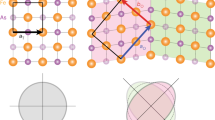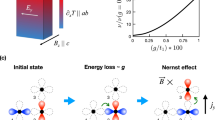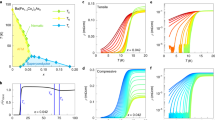Abstract
The nematic electronic state and its associated critical fluctuations have emerged as a potential candidate for the superconducting pairing in various unconventional superconductors. However, in most materials their coexistence with magnetically ordered phases poses a significant challenge in determining their importance. Here, by combining chemical and hydrostatic physical pressure in FeSe0.89S0.11, we access a nematic quantum phase transition isolated from any other competing magnetic phases. From quantum oscillations in high magnetic fields, we trace the evolution of the Fermi surface and electronic correlations as a function of applied pressure and detect a Lifshitz transition that separates two distinct superconducting regions. One emerges from the nematic phase with a small Fermi surface and strong electronic correlations, while the other one has a large Fermi surface and weak correlations that promotes nesting and stabilization of a magnetically ordered phase at high pressures. The absence of mass divergence at the nematic quantum phase transition suggests that the nematic fluctuations could be quenched by the strong coupling to the lattice or local strain effects. A direct consequence is the weakening of superconductivity at the nematic quantum phase transition in the absence of magnetically driven fluctuations.
This is a preview of subscription content, access via your institution
Access options
Access Nature and 54 other Nature Portfolio journals
Get Nature+, our best-value online-access subscription
$29.99 / 30 days
cancel any time
Subscribe to this journal
Receive 12 print issues and online access
$209.00 per year
only $17.42 per issue
Buy this article
- Purchase on Springer Link
- Instant access to full article PDF
Prices may be subject to local taxes which are calculated during checkout




Similar content being viewed by others
Data availability
The experimental data in our manuscript are available through the ORA depository at the University of Oxford at https://doi.org/10.5287/bodleian:2REyEPKZX. Other information is available from the corresponding authors upon reasonable request.
References
Sachdev, S. & Keimer, B. Quantum criticality. Phys. Today 64, 29–35 (2011).
Schofield, A. J. Non-Fermi liquids. Contemp. Phys. 40, 95–115 (1999).
Pomeranchuk, I. I. On the stability of a Fermi liquid. Phys. Rev. Lett. 8, 361 (1958).
Fernandes, R. M., Chubukov, A. V. & Schmalian, J. What drives nematic order in iron-based superconductors? Nat. Phys. 10, 97–104 (2014).
Lederer, S., Schattner, Y., Berg, E. & Kivelson, S. Superconductivity and non-Fermi liquid behavior near a nematic quantum critical point. Proc. Natl Acad. Sci. USA 114, 4905–4910 (2017).
Sprau, P. O. et al. Discovery of orbital-selective Cooper pairing in FeSe. Science 357, 75–80 (2016).
Mizuguchi, Y., Tomioka, F., Tsuda, S., Yamaguchi, T. & Takano, Y. Superconductivity at 27 K in tetragonal FeSe under high pressure. Appl. Phys. Lett. 93, 152505 (2008).
Medvedev, S. et al. Electronic and magnetic phase diagram of β-Fe1.01Se with superconductivity at 36.7 K under pressure. Nat. Mater. 8, 630–633 (2009).
Terashima, T. et al. Pressure-induced antiferromagnetic transition and phase diagram in FeSe. J. Phys. Soc. Jpn 84, 063701 (2015).
Terashima, T. et al. Fermi surface reconstruction in FeSe under high pressure. Phys. Rev. B 93, 094505 (2016).
Wang, F., Kivelson, S. A. & Lee, D.-H. Nematicity and quantum paramagnetism in FeSe. Nat. Phys. 11, 959–963 (2015).
Wang, Q. et al. Strong interplay between stripe spin fluctuations, nematicity and superconductivity in FeSe. Nat. Mater. 15, 159–163 (2016).
Sun, J. P. et al. High-T c superconductivity in FeSe at high pressure: dominant hole carriers and enhanced spin fluctuations. Phys. Rev. Lett. 118, 147004 (2017).
Kothapalli, K. et al. Strong cooperative coupling of pressure-induced magnetic order and nematicity in FeSe. Nat. Commun. 7, 12728 (2016).
Imai, T., Ahilan, K., Ning, F. L., McQueen, T. M. & Cava, R. J. Why does undoped FeSe become a high-T c superconductor under pressure? Phys. Rev. Lett. 102, 177005 (2009).
Bendele, M. et al. Pressure induced static magnetic order in superconducting FeSe1−x. Phys. Rev. Lett. 104, 087003 (2010).
Watson, M. D. et al. Emergence of the nematic electronic state in FeSe. Phys. Rev. B 91, 155106 (2015).
Watson, M. D. et al. Suppression of orbital ordering by chemical pressure in FeSe1−xSx. Phys. Rev. B 92, 121108 (2015).
Coldea, A. I. et al. Evolution of the low-temperature Fermi surface of superconducting FeSe1−xSx across a nematic phase transition. npj Quantum Mater. 4, 2 (2019).
Reiss, P. et al. Suppression of electronic correlations by chemical pressure from FeSe to FeS. Phys. Rev. B 96, 121103 (2017).
Hosoi, S. et al. Nematic quantum critical point without magnetism in FeSe1−xSx superconductors. Proc. Natl Acad. Sci. USA 113, 8139–8143 (2016).
Matsuura, K. et al. Maximizing T c by tuning nematicity and magnetism in FeSe1−xSx superconductors. Nat. Commun. 8, 1143 (2017).
Xiang, L. et al. Dome of magnetic order inside the nematic phase of sulfur-substituted FeSe under pressure. Phys. Rev. B 96, 024511 (2017).
Yip, K. Y. et al. Weakening of the diamagnetic shielding in FeSe1−xSx at high pressures. Phys. Rev. B 96, 020502 (2017).
Coldea, A. I. & Watson, M. D. The key ingredients of the electronic structure of FeSe. Annu. Rev. Cond. Matt. Phys. 9, 125–146 (2018).
Chubukov, A. V., Khodas, M. & Fernandes, R. M. Magnetism, superconductivity, and spontaneous orbital order in iron-based superconductors: which comes first and why? Phys. Rev. X 6, 041045 (2016).
Paul, I. & Garst, M. Lattice effects on nematic quantum criticality in metals. Phys. Rev. Lett. 118, 227601 (2017).
Rosch, A. Interplay of disorder and spin fluctuations in the resistivity near a quantum critical point. Phys. Rev. Lett. 82, 4280–4283 (1999).
Maslov, D. L., Yudson, V. I. & Chubukov, A. V. Resistivity of a non-Galilean–invariant Fermi liquid near Pomeranchuk quantum criticality. Phys. Rev. Lett. 106, 106403 (2011).
Löhneysen, Hv, Rosch, A., Vojta, M. & Wölfle, P. Fermi-liquid instabilities at magnetic quantum phase transitions. Rev. Mod. Phys. 79, 1015–1075 (2007).
Oliver, G. T. Quantum Multicriticality. PhD thesis, Univ. Birmingham (2017).
Wang, X. & Berg, E. Scattering mechanisms and electrical transport near an Ising nematic quantum critical point. Phys. Rev. B 99, 235136 (2019).
Licciardello, S. et al. Electrical resistivity across a nematic quantum critical point. Nature 567, 213–217 (2019).
Kasahara, S. et al. Evolution from non-Fermi- to Fermi-liquid transport via isovalent doping in BaFe2(As1−xPx)2 superconductors. Phys. Rev. B 81, 184519 (2010).
Analytis, J. G. et al. Transport near a quantum critical point in BaFe2(As1−xPx)2. Nat. Phys. 10, 194–197 (2014).
Watson, M. D. et al. Dichotomy between the hole and electron behavior in multiband superconductor FeSe probed by ultrahigh magnetic fields. Phys. Rev. Lett. 115, 027006 (2015).
Tomita, T. et al. Correlation between T c and crystal structure in S-doped FeSe superconductors under pressure: studied by x-ray diffraction of FeSe0.8S0.2 at low temperatures. J. Phys. Soc. Jpn. 84, 1–8 (2015).
Kasahara, S. et al. Field-induced superconducting phase of FeSe in the BCS–BEC cross-over. Proc. Natl Acad. Sci. USA 111, 16309–16313 (2014).
Shoenberg, D. Magnetic Oscillations in Metals (Cambridge Univ. Press, Cambridge, 1984).
Terashima, T. et al. Anomalous Fermi surface in FeSe seen by Shubnikov–de Haas oscillation measurements. Phys. Rev. B 90, 144517 (2014).
Hanaguri, T. et al. Two distinct superconducting pairing states divided by the nematic end point in FeSe1−xSx. Sci. Adv. 4, eaar6419 (2018).
Sato, Y. et al. Abrupt change of the superconducting gap structure at the nematic critical point in FeSe1−xSx. Proc. Natl Acad. Sci. USA 115, 1227–1231 (2018).
Kuwayama, T. et al. 77Se-NMR study under pressure on 12%-S doped FeSe. J. Phys. Soc. Jpn 88, 033703 (2019).
Wiecki, P. et al. Persistent correlation between superconductivity and antiferromagnetic fluctuations near a nematic quantum critical point in FeSe1−xSx. Phys. Rev. B 98, 020507 (2018).
Shishido, H. et al. Evolution of the Fermi surface of BaFe2(As1−xPx)2 on entering the superconducting dome. Phys. Rev. Lett. 104, 057008 (2010).
Massat, P. et al. Collapse of critical nematic fluctuations in FeSe under pressure. Phys. Rev. Lett. 121, 077001 (2018).
Labat, D. & Paul, I. Pairing instability near a lattice-influenced nematic quantum critical point. Phys. Rev. B 96, 195146 (2017).
de Carvalho, V. S. & Fernandes, R. M. Resistivity near a nematic quantum critical point: impact of acoustic phonons. Phys. Rev. B 100, 115103 (2019).
Bristow, M. et al. Anomalous high-magnetic field electronic state of the nematic superconductors FeSe1−xSx. Preprint at https://arXiv.org/abs/1904.02522 (2019).
Carlson, E. W., Dahmen, K. A., Fradkin, E. & Kivelson, S. A. Hysteresis and noise from electronic nematicity in high-temperature superconductors. Phys. Rev. Lett. 96, 097003 (2006).
Jaramillo, R., Feng, Y., Wang, J. & Rosenbaum, T. F. Signatures of quantum criticality in pure Cr at high pressure. Proc. Natl Acad. Sci. USA 107, 13631–13635 (2010).
Böhmer, A. E. et al. Lack of coupling between superconductivity and orthorhombic distortion in stoichiometric single-crystalline FeSe. Phys. Rev. B 87, 180505 (2013).
Böhmer, A. E., Taufour, V., Straszheim, W. E., Wolf, T. & Canfield, P. C. Variation of transition temperatures and residual resistivity ratio in vapor-grown FeSe. Phys. Rev. B 94, 024526 (2016).
Proust, C., Vignolle, B., Levallois, J., Adachi, S. & Hussey, N. E. Fermi liquid behavior of the in-plane resistivity in the pseudogap state of YBa2Cu4O8. Proc. Natl Acad. Sci. USA 113, 13654–13659 (2016).
Massat, P. et al. Charge-induced nematicity in FeSe. Proc. Natl Acad. Sci. USA 113, 9177–9181 (2016).
Acknowledgements
We thank P. Cai for technical support with setting up the Physical Property Measurement System pressure cell and A. Chubukov, E. Berg, R. Fernandes, I. Paul, R. Valenti, I. Vekhter, M. Watson, Z. Zajicek, S. Parameswaran and S. Simon for useful discussions and comments. This work was mainly supported by the EPSRC (EP/I004475/1, EP/I017836/1). A.A.H. acknowledges the financial support of the Oxford Quantum Materials Platform Grant (EP/M020517/1). A portion of this work was performed at the National High Magnetic Field Laboratory, which is supported by National Science Foundation Cooperative Agreement No. DMR-1157490 and the State of Florida. Part of this work was supported by HFML-RU/FOM and LNCMI-CNRS, members of the European Magnetic Field Laboratory (EMFL) and by EPSRC (UK) via its membership to the EMFL (grant no. EP/N01085X/1). Part of this work at the LNCMI was supported by Programme Investissements d’Avenir under the programme ANR-11-IDEX-0002-02, reference ANR-10-LABX-0037-NEXT. A.I.C. acknowledges the hospitality of KITP supported by the National Science Foundation under grant no. NSF PHY- 1125915. We also acknowledge financial support of the John Fell Fund of Oxford University. A.I.C. acknowledges an EPSRC Career Acceleration Fellowship (EP/I004475/1) and Oxford Centre for Applied Superconductivity.
Author information
Authors and Affiliations
Contributions
A.I.C. proposed and supervised the project. P.R., D.G. and A.I.C. performed experiments in the hybrid magnet in Tallahassee. P.R., W.K., L.D., M.B. and A.I.C. performed experiments in pulsed fields in Toulouse. A.A.H. grew the single crystals. A.J.S. provided theoretical input. P.R. and A.I.C. performed data analysis and wrote the paper with contributions and comments from all of the authors.
Corresponding authors
Ethics declarations
Competing interests
The authors declare no competing interests.
Additional information
Peer review information Nature Physics thanks Yann Gallais, Maxim Khodas, Liling Sun and the other, anonymous, reviewer(s) for their contribution to the peer review of this work.
Publisher’s note Springer Nature remains neutral with regard to jurisdictional claims in published maps and institutional affiliations.
Supplementary information
Supplementary Information
Supplementary Figs. 1–9 and refs. 1 and 2.
Rights and permissions
About this article
Cite this article
Reiss, P., Graf, D., Haghighirad, A.A. et al. Quenched nematic criticality and two superconducting domes in an iron-based superconductor. Nat. Phys. 16, 89–94 (2020). https://doi.org/10.1038/s41567-019-0694-2
Received:
Accepted:
Published:
Issue Date:
DOI: https://doi.org/10.1038/s41567-019-0694-2
This article is cited by
-
Unusual crossover from Bardeen-Cooper-Schrieffer to Bose-Einstein-condensate superconductivity in iron chalcogenides
Communications Physics (2023)
-
Expanded quantum vortex liquid regimes in the electron nematic superconductors FeSe1−xSx and FeSe1−xTex
Nature Communications (2023)
-
Resurgence of superconductivity and the role of dxy hole band in FeSe1−xTex
Communications Physics (2023)
-
Quantum oscillations of the quasiparticle lifetime in a metal
Nature (2023)
-
Comparison of temperature and doping dependence of elastoresistivity near a putative nematic quantum critical point
Nature Communications (2022)



